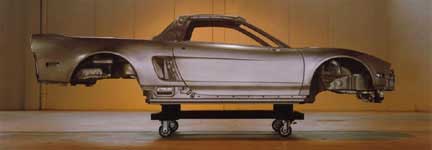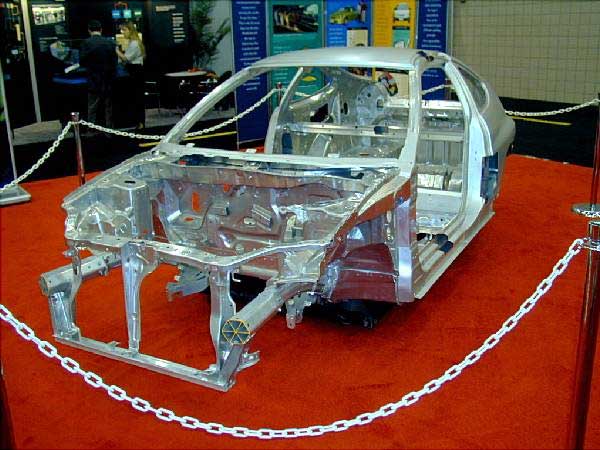
Download the PowerPoint presentation here
PowerPoint information: fuel efficiency and health effects
Lean Burn Temperature.
There is something called a wall effect that quenches the
combustion of hydrocarbons near the comparatively cool engine wall.
The stoichiometric ratio is what is needed for theoretically complete
combustion, but it is insufficient to counteract the wall effect.
Thus by providing more oxygen, lean burn allows for more complete
combustion near the engine wall. And since there is more combustion
near the engine wall, the engine absorbs more heat.
NOX Reduction
While looking for a reference for the explanation above, I ran across
an interesting tidbit about NOx. HC and CO must be oxidized, thus O2
must flow into the cat. But NOx must be reduced back to N2. And we
do not have the hydrogen that one would normally use to perform the
reduction in the cat conv. So how does the cat do it? Curious, it
appears you must have CO! Which explains the cycling. And one heck
of a balancing act.
http://www.autoshop101.com/forms/h56.pdf
"Catalyst reduction.
First nitrogen oxide gives up its oxygen. This only occurs when a
sufficient amount of carbon monoxide is available for the oxygen to
bond with. This chemical reaction results in the reduction of
nitrogen oxide to pure nitrogen and oxidation of the carbon monoxide
to form carbon dioxide."
~~~~~
A must read on combustion chemistry that refers, albeit briefly, to
the wall effect is part one of the link above found here:
http://www.autoshop101.com/forms/h55.pdf
All the nuances of shape on the Insighr add up to probably the lowest wind
resistance ever
on a production car - a drag coefficient(Cd) of 0.25.
Today,any car with a Cd under 0.30 is considered "slick" by most standards.
For comparison, the Honda Civic hatchback,with about the same 1.9m2 frontal
area
as the insight has a Cd of 0.36,which Honda engineers translates
into 32% more horsepower to run at highway speeds.
How did Honda designers mange to cut drag so much?
First off they chose a basic TEARDROP SHAPE for the car naturally disturbs
airflow going around it the least.
The car cross section tapers,going front to back ,
such that the rear wheels are 10 cm closer together(track than the front)
And the rear wheels themselves are enclosed by the rear skirts to smooth
airflow.
Since EVEN SMOOTH AIRFLOW OVER A TEARDROP SHAPE EVENTUALLY SEPARATES INTO
TURBULENT FLOW
the body's line has an abrupt cut off,KNOWN AS THE "KAMM BACK" where the
flow can break cleanly and
predictably from the body.(aerodynamic picture included)
In contrast, rounded bodies can have the flow separation point move fore and
aft,
depending on conditions,causing
handling changes , and also may generate lift, reducingrear wheel grip.
Up front, the low , rounded front end is designed to generate minimum
turbulence-
with the side benefit of
an improved front view for the driver.As air moves over the hood,is
trailing edge and cowl are shapeed to send air over the windshield wipers,
lowering their drag and flow separation effect, and up the highly raked
windshield.
But there is more to aerodynamics than meets the eye.
The underside of the insight is flat to keep airflow smooth and drag down.
Fairings around those areas that need to remain open, such as the exhaust
and fuel tank ,
direct the airflow for least impact.
The designers then sloped the rear of the cat bottom upward at a 5° angle,
to smoothly feed air from underneath into the low pressure region behind the
car.
Finally , to further cut turbulence, their are small airdams ahead of the
front wheels,
along with the rear of the front wheels openings being inset and faired as
well.
Moving rearward,the lower sills along the sides extend downward,
functioning as an air damm to limit airflow going underneath the car,
which would reduce road hugging low pressure.
At least with the Insight, form follows function resulting in overall
operating efficiecy
"
end of copy
So watch out with a theoretical teardrop formed trailer.
Aerodynamics will be disturbed.
As an Private Pilot, this effect is called parasitic drag. There is actually a graphed drag curve that is shaped like a "U" and at the lower part of the "U" is where your best glide speed is located because parasitic drag and induced drag are at their least. I believe this speed for the Insight is somewhere under 60mph. Since there is no induced drag (ie no control surfaces) slower speeds won't create drag on the Insight. The faster you go the more air you have to punch through. :)
The equation can be cribbed from most physics textbooks, but for wind
resistance is:
rho/2 * Cd * F * S^3
where rho is the density of air and Cd is a non-dimensional drag
coefficient. Since rho is around 1.2 kg/m^3, the rho/2 term is around
0.6. The Cd is the "coefficient of drag", the F is the front-view
cross-sectional area, and the S is the speed. (keep the units
together, boys and girls!) The speed where the resistance = engine
power is: voila! peak speed (theoretical)
Essentially, it goes up with the cube of the speed - go twice as
fast, you need eight times as much force.
The Insight has a very low Cd of 0.25 (GM Impact EV1=0.19), and a
very low F.
The upshot is that you can often get a feel for how much engine a
vehicle needs from a front view and a side view. Trucks and SUVs are
essentially large boxes flying into the wind. From the rear-view
mirror, a Ford Excursion is all grill.
The few times I've taken mine really fast (and there aren't many
places for that around here), it was interesting how going from 60-70
was just effortless as 80-90. The feel in a pickup truck, van or SUV
is quite different. I had my 1986 CRX DX up to 110 one time and it
was neat how the 110 happened at an RPM of exactly where the peak
horsepower was - any faster and there'd be less power.
BTW, Cd figures for a variety of cars here:
http://www.darklair.com/cd.html
Very interesting list! Some other vehicles that you'd consider very
fast or streamlined didn't do so well.
NSX total weight 3153 lbs (88% sheet Al, 12% Die-cast Al)

Aluminum Unit-Body Construction
*
World's first aluminum production car
*
Unit body weighs only 462 lbs - 40% less than steel
*
Incorporates unique high-strength extruded-aluminum side sills
*
Unique heat treatment ensures surfaces hardness
*
Highly corrosion resistant
*
High torsional and bending rigidity
Insight total weight 1878 lbs (57% sheet Al, 30% die-cast Al, 13% extruded Al)
